YouTube has become a go-to platform for countless users worldwide. However, the experience can often be interrupted by ads that can be annoying and detract from the content enjoyment. Many users have resorted to using ad blockers to get around this issue, but YouTube has implemented various measures to detect and thwart these blockers. In this blog post, we'll explore effective methods to bypass
Understanding YouTube's Ad Block Detection

Let’s face it: ads are a part of the modern online experience, especially on platforms like YouTube. However, YouTube has developed clever systems to identify when users employ ad blockers. Here’s a breakdown of how
- Script Detection: YouTube utilizes JavaScript to check if certain elements and scripts associated with ads are loaded. If they are absent, it raises a flag.
- Data Monitoring: The platform tracks user engagement, including how many ads are skipped, watched, or blocked. This data helps them understand typical behavior and detect anomalies.
- Network Requests: YouTube monitors the network requests made by your browser. If requests for ad content are missing, it becomes suspicious.
- Cookie Management: Ad blockers often tamper with cookies that help track ad interactions. YouTube utilizes cookie checks to understand if the ad viewing experience has been altered.
In response to these detection methods, YouTube may display messages prompting users to disable their ad blockers, limit access to content, or even provide non-premium features that users find frustrating. But don't worry—understanding how the detection works is the first step toward finding effective strategies to counter it.
| Ad Detection Method | How it Works |
|---|---|
| Script Detection | Checks for essential ad scripts |
| Data Monitoring | Tracks engagement with ads |
| Network Requests | Looks for missing ad resource requests |
| Cookie Management | Analyzes cookie modifications |
Understanding these detection mechanisms helps in navigating YouTube while keeping your ad blockers intact. So, now that you're equipped with some knowledge, let’s explore the methods to bypass these detections effectively!
Also Read This: How to Change a Featured Video on Dailymotion
Common Ad Blocking Tools

In the ever-evolving landscape of online content, many users opt for ad blockers to enhance their browsing experience. Whether it's to avoid distractions or improve page load times, various tools can help you seamlessly block unwanted ads on platforms like YouTube. Here’s a list of some popular ad-blocking tools:
- uBlock Origin: A highly efficient ad blocker that’s lightweight and customizable. It uses less memory than some of its competitors and effectively blocks a wide range of ads.
- AdBlock Plus: One of the most well-known ad blockers, AdBlock Plus allows users to create custom filters. It can block ads on a variety of sites, including YouTube, and even supports Acceptable Ads, which are non-intrusive.
- AdGuard: This is not only an ad blocker but also a full-fledged privacy protection tool. AdGuard provides an extensive range of features, including tracking protection and phishing protection.
- Brave Browser: An entire browser built with privacy in mind, Brave blocks ads and trackers by default without needing additional extensions.
While these tools can significantly enhance your viewing experience, it's worth noting that some websites, including YouTube, are increasingly implementing measures to thwart ad blockers. This means that even the best ad blockers may face challenges. Stay tuned, as we will discuss techniques to combat these detection methods in the next section.
Also Read This: How to Make Auto Like on Facebook: Dailymotions Simple Trick
Techniques to Bypass Ad Block Detection
Even the best ad blockers may struggle against YouTube’s formidable ad block detection system. However, users have developed several clever techniques to bypass these restrictions. Here are some effective methods:
- Browser Extensions: Use specific extensions designed to bypass ad block detection. Extensions like Video Ad-Blocker or Anti-AdBlock Killer can help you navigate around these barriers.
- Modify Site Code: For advanced users, modifying the website's code using tools like Developer Tools can sometimes hide ad block detectors. This option requires some technical know-how but can be quite effective.
- Using Alternate Video Platforms: While YouTube is king, consider using platforms like Vimeo or Dailymotion. These sites often have fewer ads and less strong detection protocols.
- Whitelist YouTube: Some ad blockers allow you to whitelist certain sites. If you want to support content creators while still blocking ads, consider allowing ads on some channels while maintaining protection elsewhere.
By employing these techniques, you can enhance your viewing experience while continuing to enjoy all of YouTube’s fascinating content. Just remember that ad revenue supports creators, so balancing usability with ethical browsing is always a good practice!
Also Read This: Fast Hair Growth Tips and Home Remedies for Healthy Hair
Using Browser Extensions for Enhanced Ad Blocking
When it comes to blocking ads on YouTube, browser extensions are your best friends. They make the process simple and efficient, allowing for a much smoother viewing experience. Below, we’ll explore a few popular options that can help you effectively bypass ad detection and enjoy uninterrupted content.
- uBlock Origin: This is a highly recommended extension due to its lightweight nature and robust capabilities. It's open-source and can block various types of ads, not just on YouTube but across the web.
- Adblock Plus: A classic in the ad-blocking world, Adblock Plus lets users customize their blocking settings. You can easily allow or block ads based on your preferences.
- Enhancer for YouTube: This extension not only blocks ads but also provides various customization options for your YouTube experience, like enabling picture-in-picture mode or controlling playback speed.
To install these extensions, simply go to your browser’s extension store, search for the one you prefer, and click on “Install.” Once installed, you may need to tweak some settings to optimize your experience.
Keep in mind, however, that some ad blockers may become less effective over time as YouTube updates its platform. It's a good idea to stay updated with the latest versions of your chosen add-ons. With the right browser extension, you can say goodbye to those pesky ads and hello to uninterrupted video watching!
Also Read This: Step-by-Step Guide to Making Invoices in Excel Dailymotion Videos
Alternative Methods for Ad-Free Viewing
If browser extensions aren’t your style, or you’re looking for additional ways to enjoy ad-free viewing on YouTube, there are several alternate methods to consider. Each method has its pros and cons, so it's essential to pick one that suits your viewing habits best.
| Method | Description | Pros | Cons |
|---|---|---|---|
| YouTube Premium | A subscription service from YouTube that eliminates ads entirely. | Ad-free experience, offline viewing, background play. | Monthly fee required. |
| Changing Video URLs | By altering the URL of the video, you can sometimes bypass ads. | No need for extensions or subscriptions. | Not always reliable; can change with updates. |
| Third-party Websites | Websites like “Y2Mate” allow you to watch YouTube videos without ads by playing them on their platform. | Free and simple to use. | Potentially unsafe; can contain malware. |
Each alternative method has advantages and disadvantages, so it’s worth experimenting to see which one works best for your needs. Remember, while enjoying ad-free content is tempting, always consider safety and legality when exploring these options.
Also Read This: How to Create My Own Channel on Dailymotion for Personalization
Best Practices for Responsible Ad Blocking
Ad blocking can feel like a hot topic, and while many users enjoy the benefit of an ad-free experience, it’s crucial to approach this practice responsibly. After all, content creators often rely on ad revenue to keep producing the quality videos we love. So, let's dive into some best practices for using ad blockers without compromising the ecosystem.
- Support Your Favorite Creators: Consider subscribing to channels or supporting them through platforms like Patreon. Many content creators offer exclusive content for their supporters, which can be a win-win situation.
- Whitelist Specific Channels: Most ad blockers allow you to disable them on certain sites or use whitelisting. This means you can support channels you genuinely appreciate while blocking ads everywhere else.
- Engage With Content: If you enjoy a video, make sure to like it, comment, and share. Engagement tells the algorithm that this content is valuable, which helps promote it further.
- Monitor Your Ad Blocker: Ensure your ad blocker is up to date. Some are more effective than others at respecting creator revenue streams. Look for blockers that allow you to customize your settings.
- Educate Yourself: Understand the role of advertising in the content ecosystem. Learning how and why creators monetize their content can help you make informed decisions about ad blocking.
By following these practices, you can enjoy an ad-free experience while still supporting the wonderful creators who keep YouTube alive and thriving.
Conclusion
To sum it all up, navigating the world of YouTube ads and ad-block detection can be a bit of a minefield. However, with the right methods and a responsible approach, it’s entirely possible to enhance your viewing experience without undermining the content creators you enjoy. Remember, while ad blockers can significantly improve your online experience, they also have implications for revenue generation for creators.
By employing tactics like whitelisting channels, actively supporting creators, and staying educated about the ecosystem, you can strike a balance between ad-free viewing and creator support. So, whether you decide to tweak your ad blocker settings or find other means of support, remember that your engagement matters.
As you navigate this journey, keep in mind that every click, every like, and every comment helps shape the content landscape. Enjoy your viewing experience, but do so with a mindset of respect and support for those who bring the content to life!
 admin
admin








